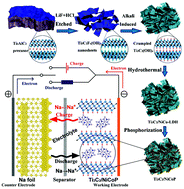Alkali-induced 3D crinkled porous Ti3C2 MXene architectures coupled with NiCoP bimetallic phosphide nanoparticles as anodes for high-performance sodium-ion batteries†
Abstract
To enhance the structural stability and improve the poor electrochemical reaction kinetics of anodes for sodium ion batteries (SIBs), we develop a novel strategy to couple NiCoP bimetallic phosphide nanoparticles with alkali-induced 3D interconnected crinkled porous Ti3C2 MXenes as anodes for high-performance SIBs. The interconnected 3D Ti3C2 crinkled architectures can establish a 3D conductive network, abundant open pores and large surface area, which provides a 3D conductive highway and unblocked channels for a rapid charge transfer process and for electrolyte storage, and makes fully close contact between the electrode and electrolyte. The unique MXene structure can effectively tolerate volume expansion and prevent aggregation and pulverization of NiCoP nanoparticles during Na+ insertion/extraction processes. The NiCoP bimetallic phosphide possesses richer redox reaction sites, higher electrical conductivity and low charge transfer impedance. The synergistic effect between the components of NiCoP and MXene Ti3C2 with high structural stability and electrochemical activity leads to excellent electrochemical performance, retaining a specific capacity of 261.7 mA h g−1 at a current density of 1 A g−1 for 2000 cycles. The present strategy of an in situ phosphization route and coupling phosphides with crinkled 3D Ti3C2 can be extended to other novel electrodes for high-performance energy storage devices.



 Please wait while we load your content...
Please wait while we load your content...